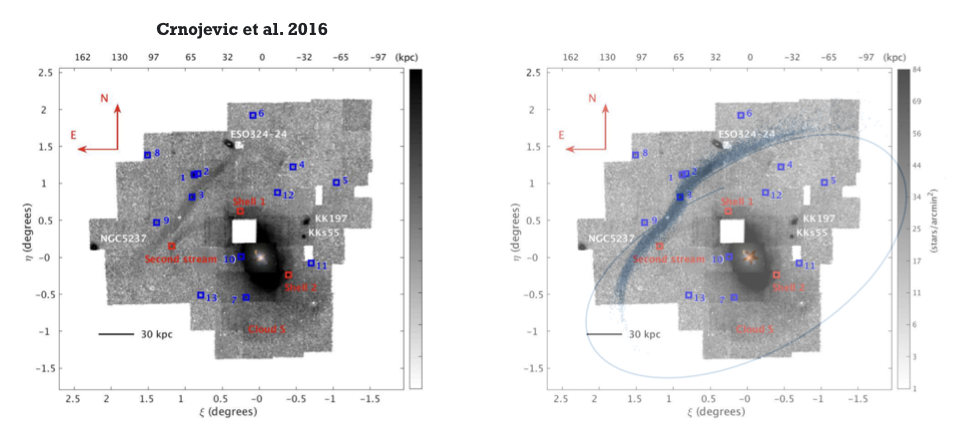
I recently attended the IAU Symposium 355 “The Realm of the Low Surface Brightness Universe”, where I had the chance to get an update on the current observational status of, among other things, detecting streams in external galaxies. Denija Crnojevic showed her map (Crnojevic et al. 2016) of the nearby galaxy, Centaurus A (see left panel of the Figure above). This lead to some discussion on the “straightness” of the stellar stream emerging from the dwarf galaxy referred to as Dw3 in the figure. Some people found the straightness odd and argued that the stream must be part of a “plane of satellites”. I thought, instead, that maybe the stream is straight because it’s close to apocenter and has a large velocity component in the direction of the plane of the stream. To test this idea, I generated “mock-streams” using Fardal et al. (2015)’s “particle spray” method implemented in gala (Price-Whelan et al. 2018) to see if I could reproduce the overall morphology of the stream in a simple potential with a disk, bulge and dark matter halo. Specifically, I attempted to reproduce the stream’s S-shape, width, length, its lack of curvature, and its projected separation to its host, Cen A. After a few attempts where I used 1) the s-shape to determine the direction of motion, 2) the width of the stream to estimate the mass of the progenitor, 3) the length of the stream to estimate the age of the stream and 4) where I fixed the distance of Dw3 to be 60 kpc above the disk of Cen A (as observed in projection), I managed to generate a stream which looked very similar to the observed stream (see the right panel of the figure above). The blue line shows the last 4 Gyr of evolution of the progenitor’s orbit, and the blue points show a mock-stream evolved forward from the endpoint of that orbit until present day. This simulated stream is definitely not the final solution, but with some tweaks to make to potential more similar to that of Cen A (right now I used a MW type potential) and after obtaining kinematic information from Denija’s collaborators, we hope to get a good match to the system. The point here is simply that finding a somewhat reasonable solution wasn’t difficult, and that there’s nothing odd about this stream.